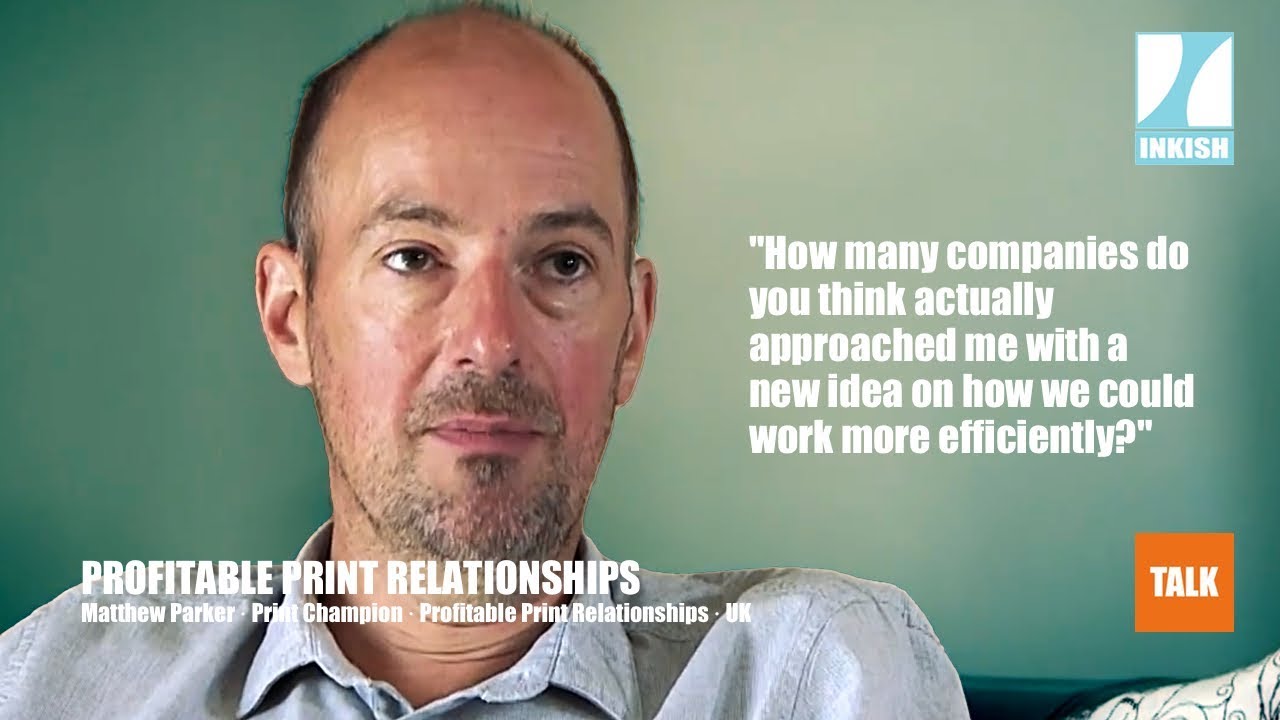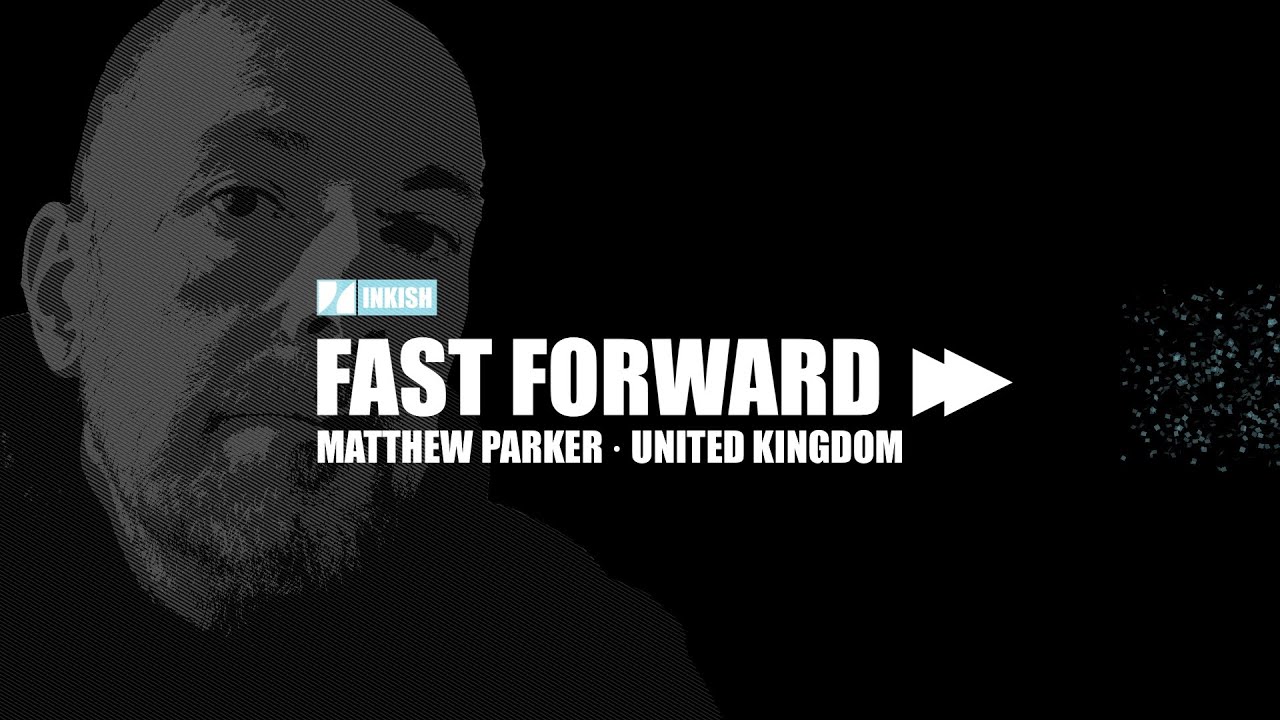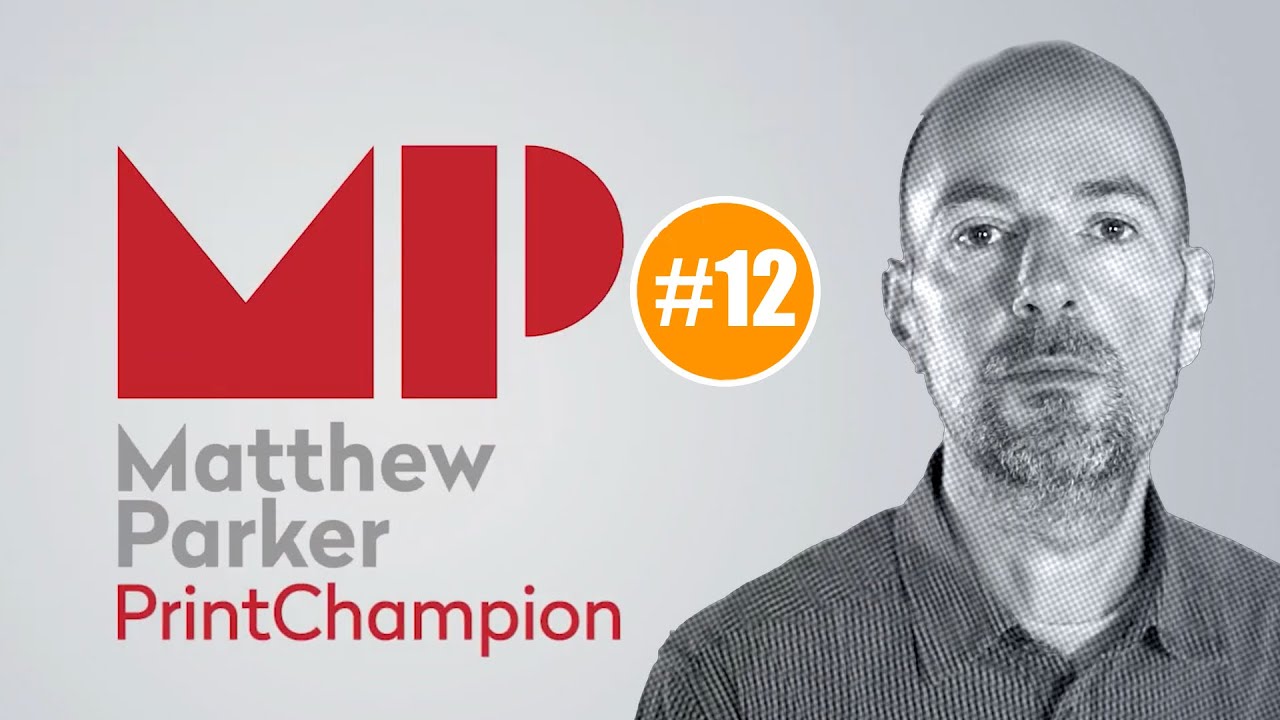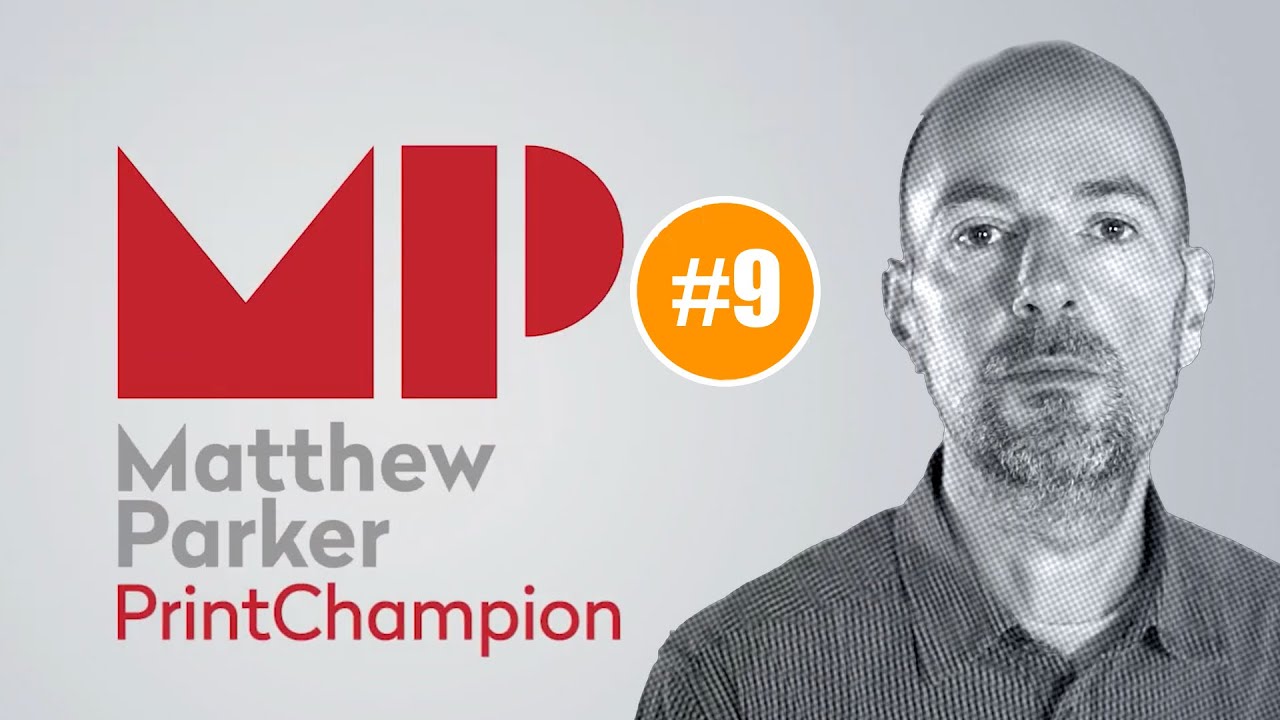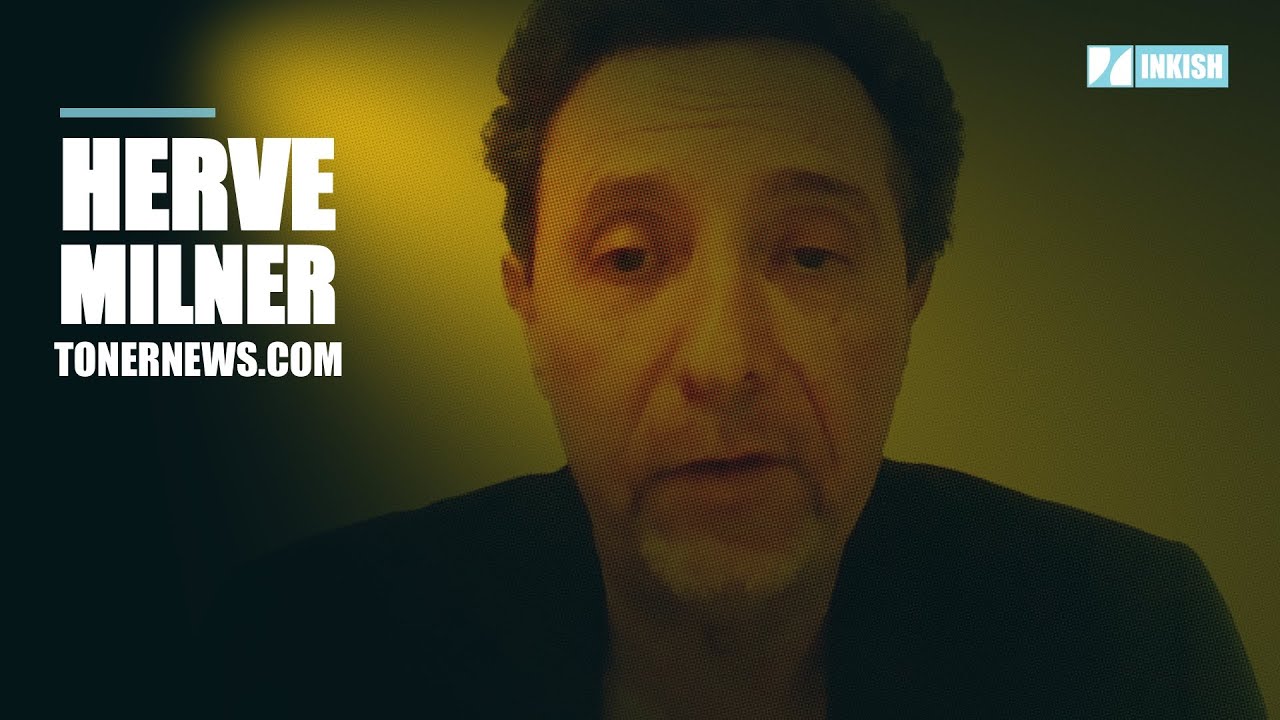In this INKISH Conversations, we speak with Print Champion Matthew Parker from Profitable Print Relationships. Matthew Parker used to work as a print buyer in a larger publishing group and have gained much knowledge over a 15+ years professional life to buy print, and in his company and role as Print Champion, he lectured business owners, salespeople, and industry in the art of sales. His intense focus on hos printers can make more money selling print, how they should change the emphasize from price to value is stunningly great and so much aligned with the very reason for the existence of INKISH.TV. Enjoy this 30-minute ‘conversations’ with your Print Champion Matthew Parker.
TRANSCRIPTION
We’re here with Matthew from Profitable Print Relationships, right? I got that right now, right?
You did, yes.
It’s actually funny that I have difficulties remembering because I read some of your stuff and actually like what you’re doing, and that is of course also the reason why I invited myself to come and visit you. But maybe for our viewers you can give a little bit more insight. Who are you and what is your background?
So my name’s Matthew Parker. I’m the Champion of Print at Profitable Print Relationships. My background is in buying print, so I used to buy print for about 20 years. I still buy some now. When I finished my full-time print buying career, I set up on my own and I thought I was going to be a strategic consultant to help big companies buy more print. And lots of the suppliers I’ve been using started ringing me up and they went, “Matthew, you were really hard to deal with so come and tell us how we can get through to people like you.” And that’s how Profitable Print Relationships was born. It’s kind of all about making sure that I bring the buyer’s point of view to printing companies so they understand us a bit more, can hopefully improve all their customer engagements as a result of that.
I mean that sounds awesome, but I was just curious because when you say that you do this kind of thing, are you like a consultancy company or how do you actually do this kind of things?
So there’s a number of ways. A lot of people engage with me through my blog, first of all. So anyone can sign up to ProfitablePrintRelationships.com and it’s free. I do a mixture of things. So I put my thoughts down in the blog and then from there, I mentor people on a one-to-one basis over Skype. I speak at conferences. I’ve published a number of books and online training courses so people can study online, and I do face-to-face training as well, and I do one-off consultancy for companies that want specific, particular projects as well. So it’s kind of pretty varied, which is great because I love everything changing the whole time.
And you’re not just a UK-based phenomenon. We have met each other on the internet, of course, but you told me that you’ve been in Israel and I mean, you’ve been many different places, right?
Yes. So what I do is all over the world, so I’ve been lucky enough on various conferences and training, it’s taken me out some great places. I’ve met some great people. But equally, like you said, it’s on internet, so actually I’ve got clients that I’ve never met face-to-face, but we work together closely on Skype and they’re all over the world. We just have to get the timezones to work occasionally.
Yeah, I guess that is the benefit of working with, for example, Skype, is that you don’t have to adust from jet lag and from things like that. Of course, that’s just a matter of having two different timezones to match each other.
Absolutely, yeah.
So I think that we are pretty clear that you are actually trying to help the printers to understand the purchasing processes from the print buyers, so that this can help them, understanding and getting better serving the customers, right?
It’s everything to do with the customer-facing side of the printing company, so I’m really passionate about the sales and marketing getting better because I think it’s something that the many companies in the printing industry could improve greatly. I can also help them think from the buyer’s point of view of how buyers negotiate, how they buy, what makes them press the buy button.
But then it goes on into how we look after our customers afterwards and the customer journey and what we do to keep our customers on board and stop them going off to the competition. So that whole piece is, you know, as long as it’s about talking about the customer, then that’s where I think I can help the printing industry.
One of the things that I read, if I don’t remember wrong, is also that you are talking also about the added value and actually getting a print higher in the value perception of customers. Is that true?
Yeah, absolutely. Because one of the issues that I see at the moment is that we tend to sell print, print’s being commoditized. And we can all buy business cards for cheaper every year online. So we’ve got to sell something other than prints if we want to be seen as people who can add value to customers and their companies, because it’s only at that point they’re going to start spending more. Print is what we do, print’s the solution, but maybe we’ve got to frame it in a different way for customers. So on a very simple level, direct mail now is getting huge results for many companies because it’s unusual now. We’ve got drowned out by email noise.
So now that is the strange kind of marketing that is direct mails and just 15 years ago that was like the standard, right?
Absolutely. But rather than going, “Do you want some direct mail?” We need to go into customers and talk to them about how printing companies are partners who can help people bring more customers on board, let people know about products, help customers and prospects know more about the company because they’ve got a communication channel that’s different, that’s unusual and works. And with the right knowledge that the printing company can bring about how direct mail works for particular companies, that brings a very different conversation to how many pieces of direct mail to you want? So something we’ve moved from commodity to value at that point.
If I should tease you a little bit, I hope that’s okay.
Sure.
I was just wondering, because in my career, also being in selling print for many years, I have been attending a lot of sales training classes and I think that from my perspective, all of them have been good, but then I tend to forget. See, I couldn’t even remember your name. I was just wondering, when you go and do these conferences and you interact with the customers, I guess they probably pay you some money to teach them things that they believe they need, and I’m sure that you’re great at it. But do you think that people can take your tools and turn them into actions and make it operational?
Yeah, absolutely. I wouldn’t do it if people couldn’t do that, so I’m sure you’ve been on sales training where people are kind of giving four page spreadsheets to fill out about prospects.
How you do it, how you make the phone calls, how you script your … I got wiser with age, I’ll tell you.
I’ve also seen ones where people have gone, “Right, here’s your prospect.” You fill out a four or five page spreadsheet about these, and in real life, no one does that, or very rarely. So I don’t teach rocket science, I teach simple strategies that people can use and that they can put into practice the next day.
And I don’t think I’m teaching anything that’s ground-breakingly new, but what I’m doing is I’m framing it for the print industry. They’re strategies I’ve used myself for my business, I know they work for other printing companies, I’ve seen people put them into use. T
he key thing is to get people to do it, so I’d say that we get a lot of people that go away and put it into action and there are some people who just go back and start doing what they always did. And if you’re going to go on training, if you’re going to go on learning, then you’ve got to be prepared to go and do something with it afterwards, otherwise there was no point in you doing it. But what I try and do is make sure that people have an action plan after they’ve learned with me, that they know what they’re going to do next.
When I’m mentoring people on Skype, then I keep them accountable and we go through, “Here’s what you’re going to do in the next two weeks before we talk again,” and then we review, “What have you done? Were there any barriers? What’s been successful,” and the next two weeks. So I keep people accountable and make sure they do put it into action at that point. It’s harder after a one-day training course because you go away. And I try to keep in touch with people and hear their successes.
Sometimes maybe also the one-day courses is more like inspiration, isn’t it?
It is.
Yeah, and I think that … I don’t know if it’s true, but I could just ask you as a question because I was just thinking that if you go … If you are like a company and your management want your sales people or your project managers or whoever’s responsible for interaction with your customers, go to a lecture by you, I guess it’s really pinpoint to you there’s a need for something, right?
Yeah.
Because when the management decide to pay you or pay others to do training, it is because of a well-defined need, I guess.
Yeah, and actually I’ve found that there’s people who’ve come to my open courses, who’ve paid for it out of their own pocket, because they want to improve. So I’ve been doing some open courses with Antalis recently and the Digital Academy in Leicestershire. I’ve got all sorts of different companies coming on there. But yeah, some people have paid for it themselves because they want to improve their results and they see this as a way of doing it. And I guess what makes me different from some of the other training out there is I’ve been sold to by the 1,400 different printing companies. So I know what works, I know what doesn’t. Everything I do is print specific, but I’ve had that bit of seeing so many printing companies in action, and I think that’s the bit that maybe makes me different from a lot of the other people out there.
Tease you a little bit more. Maybe you didn’t feel teased so far but I will try anyway. You talk about your experience as a print buyer yourself?
Yeah.
I was just wondering, everything in the society changes so fast. So how much of your legacy can you actually … Is that still a hard rock truth from what you did 15 years ago? Or is it more like the mentality?
It’s about the mentality. The role that I had nearly 15 years ago, that there’s very few full-time print buyers left. They’re a dying breed. There’s increasingly less people in procurement doing this as well. A lot of the buyers are kind of more down on the coal, facing other roles. But actually I think a lot of them think the same way that I did when I was buying print, and I see that many printing companies maybe haven’t changed their sales techniques over the years. And they’re still focusing on selling print and not solutions. And I always remember the, sadly, very few good sales approaches I had from printing companies. They were rarely about print at that point. The interesting conversations where people engaged me, where they encouraged me to spend more than minimum price, were ones where we were talking about value solutions and the conversation at that point was rarely about print. And that’s what I’m trying to get over as a message to people in the industry.
Now, I was just thinking, Matthew, that some of the maker trends, if you can say that, in the printing industry, is also to buy online, to self-service. I even think that some printing companies, though they may suffering from not enough work, they’re still considering downsizing their sales department because it’s expensive. Results go ups and downs.
So I’m working with one of the leading trade printers in the UK, and the interesting bit there is, yes, people come and buy online, but the reason that they stand out and they keep their customers is the offline bit and the fact they still have conversations with their customers and they want to interact with their customers in as many different ways as possible. And actually, the message still has to be the same sometimes, even though it may be putting them through different channels. And we need to think about the customer experience as they go online as well. As someone who’s used to buying print but also thinks about it from a non-technical perspective as well, there’s quite a lot we can print to that bit. But the interesting bit that is the fact that they still need to communicate with people offline. It still has to personal, it still has to be one-to-one for the best relationships to work.
So basically, you didn’t say that but now I’m just trying to put words in your mouth. Question, are you saying that online print is, there’s some customers that they never require or they think they don’t require or need sales people or guidance or anything like that, and that kind of market would be so commoditized that they will just take it, where the printing companies can be really profitable is that though they have an online strategy, they still have people involved in selling higher value product? Do you understand my point?
Yeah, so there’s the online piece but actually the most successful relationships that built online have that personal element as well, even though it’s online. So I don’t say too much about what they do because I don’t want to give ideas to their competitors. But we live in a multi-channel world so in the same way that we don’t want to do everything over the phone, we want to send information by email when it comes to ordering online, actually some of the best communication is done over the phone or even face-to-face sometimes to build that. We can’t rely on just one channel. It may be that we’re moving from the first prime mover channel being face-to-face to being online, but yeah, lots of people still want to talk and want to get advice on what they’re doing. And it’s harder to do that online. Yes, you can do it with instant chat, but you can’t get that same level of relationship going. So I think there’s still very much a place for face-to-face sales.
And I mean, I guess that if sales people get a higher value because they are taught how to be better sales people. I think that the question about, well it’s too expensive to have sales people will become really, really secondary or even further down the road because if you have sales people that don’t perform, of course they are just expensive, right? But when you employ people you have an expectation that they become profitable and at least pay their own salary and fill up the machinery.
So two of the other things that I teach that I think are really important is, one is I do a workshop called, “How to stop buyers choosing on price.” The first two-thirds of the day is about creating a message for customers. And that’s a message that can be used in face-to-face sales but it should also be used online, in brochures, on direct mail, and all the ways you approach the customers. But I also teach people then about maybe becoming a little bit more efficient in the way that they sell. So I can get in front of my customers, multiple channels, automatically, very frequently so that I’m always front of mind for them. And that’s something that a lot of printing companies want to do more of and are maybe struggling with the right methodology to do that. And they need to do that because to rely purely on one-to-one sales in today’s world is inefficient and expensive, as you’re saying. But the sames person has to know how to do that and back up their one-to-one conversations with other efficient ways of keeping in touch with people.
And the other thing that I try and teach people is focus. So my latest book is all about 12-week sales projects and it’s about moving away from the annual sales target of, “Oh, we’re going to do X amount this year and then kind of wondering about how we do it,” to actually getting some focus on what we need, how we’re going to get there, and how we’re going to do it. And again, you need someone to move that sales and marketing activity forward, but equally, that doesn’t have to be a sales person. So for some smaller printing companies, it might be the managing director, one of the senior managers doing that, and it won’t necessarily be them ringing up customers and cold-calling every day, they may have a different way, but they still need a project with a focus to make sure they win that new business. Because most printing companies are going to lose 15-20% of their customers year on year, which is quite scary when you think about it. Now hopefully it’s going to be the small customers, but you’ve always got to be getting in new business to replace what’s tailing off.
I was just curious that the class or the course that you gave about selling on something else in price?
Yeah, how to stop buyers choosing on price.
I was just wondering, do you have a lot of attendencies from printing companies that you net?
Well, everything I do is for the printing industry.
Yeah, but that was a lead-in question.
It’s the most popular one. There’s a book on it as well and there’s a presentation. So quite a few people have seen it, but yes, it’s deliberately-
But I was just asking, is that because too many printing companies, in your opinion, is focusing on prices?
So, as a buyer, I think I was actively encouraged to buy on price by a lot of printing companies. They may not have been doing that consciously-
They start just giving you a good offer and then they discounted their own offer?
Yeah. They started off by making the conversation all about price. They may not have meant to, but in the course in the book, we explore different ways in which many print sales people are making the conversation about price and then complaining that buyers over-choose on price. When actually I think as a buyer I was the one who was encouraged to buy on price a lot of the time.
So I used to run a lot of printing tenders at one point in my career and-
But that was based on price 100%, wasn’t it?
Well here’s the interesting thing, Morten. At the end of each tender, there was a specification there, it wasn’t just price because we needed companies with the right capabilities as well, so the tender covered all that. But at the bottom of the tender, there was a paragraph which said we also actively encourage people who are tendering to come up with other ideas on how you can help us work more efficiently and save us cost. And there’s a big difference between cost and price. And if it was a new company, didn’t know me, I used to ring them up. And I said, “Read that paragraph and think about it,” because what that means is, I’m happy to spend more money with you. You come up with another solution, I spend more money with you. If it makes me more efficient, I’m fine with that.
But that’s also because you, in that company that you worked for, were “allowed” by your management to actually say that efficiency also has a price, right? Because I was just thinking that if you were not involved with anything that was regarding making your company more efficient, but it was only numbers, it was only spreadsheets, it was only target prices, then that term would have been difficult to take into consideration.
Most companies look at the wider cost aspect than just price, unless they’re buying business cards or …
Don’t say anything bad about business cards.
Business cards are great.
Just kidding.
But let’s go back to tenders a moment. So over the years, I had a lot of companies approaching me with their tender bids, and I did this for about six years. How many companies do you think actually approached me with a new idea on how we could work more efficiently and they could get some more revenue out of it?
You know, when you actually started saying that you had that paragraph, my head was spinning around zero.
Yeah, I got two out of that whole time. I was saying to printing companies, “Come on, sell more to me, make some more money out of me, that’s fine. And I was getting nothing back from them. So I was encouraging them to sell me value, and they were going, “Nah, Matthew just wants to buy on price, cheap price.”
So when you tell that story to the printers who participate in this less focusing on price sales, do they get this? Because that is also do you have the right staff, do you have the right mindset at the printers to understand that it’s not just about how cheap you can get the paper and the ink and the machines and labor. That is also that creative, that is like business development aspect. Do they get it?
Yes, they do, yeah. It maybe takes me a little bit of time…
They can make it operational as well?
That requires a bit of a mindset shift but yeah, I give them a way to do that. There’s actually a very easy way to implement and I’ve taken people through that process, I’ve done it successfully and it’s changed their message. So it can be done. But I think a lot of the printing industry at the moment, the mindset is all the buyer is interested in is in price. So therefore they sell on price. And if we believe that, it becomes a vicious circle and we end up with an ever-more price driven industry. Yeah, it does, it requires a shift in mindset. But there are companies that are doing it well and are managing it.
One of the interesting things is that print management companies, and they’re fairly commoditized now, but there’s a lot that are offering a bit more than that. They are successfully selling in to customers and making a profit before they’re buying the print or after they’re buying the print. Now, why can’t printing companies do that? And yes, it’s partly because the print management companies are buying efficiently, but then they’re making 15-20% profit on that. Why can’t printing companies do that? And they can if they think in the right mindset and they go to the right type of customer as well. So you’re always going to struggle on the professional print buyer, you’re always going to struggle with the professional procurement person, but yeah, most people who buy print aren’t in those positions.
I always check this out at workshops and very few people have most of their customers as professional procurement people. Nobody has most of their customers as professional print buyers.
It’s funny that you mention this because one of the films that I’m most proud of on INKISH.TV is actually made by … And we filmed it with Ravindra Parisnis who is the CEO or president of Federation Printers in Sweden, because they made a survey, over 2,000 companies over seven years period to try to identify which types of printing companies and binderies and brokers and large format printers and commercial printers and fine printers and bookshops and things like that, to place them in a chart to see who can actually both add value as well as things like that. And the print broker was the number one in that one. And I think what you say is right, that they may be more focused on the sales and the process and added value, but also think that the freedom and liberty to basically go for the customer’s need rather than what you have of equipment is something that is, it must be really difficult to have a 5 million pounds printer in your garage and then it’s not used because people are demanding something it can’t produce. It must be really terrible.
It must be really hard, but then go and create something with it people want, and generally it’s around. Yeah, one of the other issues I have at the moment is that if people spend that much on presses, there’s often a tendency in some cases to buy the press and then wonder how you’re going to fill it, and yeah. Something that I wonder about is should all printing companies be focusing so relentlessly on growth? Why not stay the same size, keep the same revenues, but fire the bottom 10-15% of your customers every year, the least profitable ones, and get new, more profitable customers in? And then you wouldn’t have the same race to the bottom at that point.
That sounds like very good advice and I think that is probably the easiest one to actually do and the hardest one to make the decision about, yeah.
Yeah, but if we stop focusing on the revenue and start focusing on the profits, then …
Should be an easy …
Yeah, and that’s where this 12-week sales plan comes in, because then you’re laser focused on the right type of customer. You have to know what products and what customers make you money in order to get the profits up at that point, otherwise it’s, you know, if you’re just going for more of the same customer then you’re going to struggle a bit. But I think you can grow profits without having to grow revenues.
That’s awesome, I like that. I like that.
Yeah, and that doesn’t mean we shouldn’t invest in equipment still.
No, no, of course, but it just needs to focus … I don’t know if you read anything of what I’ve been writing but you know my mantra for what I try to also with Inkish and in my writings, not just in the field but also in the writings is to make sure that people understand that you should focus on value rather than price.
Well you know I read them. I’ve shared some of yours on social media.
Oh, yeah, you have. Thank you, yeah. I actually forgot but now I remember.
But I only share things I really believe in.
Thanks a lot. And I think that the printing, it seems to be some people who’s really focusing on price, price, price in order to grow revenue at least, right? And then there’s a few … Normally I don’t mention so many names, I don’t know them as a company but I know them at a brand, MOO, here in the UK. I think, I mean to have a business that is so focused on what they do and seem to have a very good recognition from the market and still growing and maybe also make money, I don’t know. But it’s just two different worlds. The commodity printers who just turn revenue to have size, and then you have the specialists that turn in products that in my opinion, has a much higher value proposition for the end customers.
That’s what I try and teach people in the printing industry, and we haven’t always been good at it. One example is bringing web to print, which is huge values to customers. And the print industry taught me that I shouldn’t value web to print because they were offering it to me for free. Yeah, it de-valued it not just in what it was worth in paying for, but actually its value to me as a system. And I know that some companies have managed to turn that tide very well now, but there’s a lot out there with web to print that’s just gathering dust on the shelves because they’re not sure about how to sell it. And yet it’s got such big advantages to the buyer.
Matthew, where can people meet you? Where are you in the nearby future?
Okay, so first of all, please connect with me on LinkedIn. You’ll find me there if you search for Matthew Parker in print. Connect with me on Twitter, @PrintChampion, I’m there as well.
We will put this in the text as well.
Fantastic. Okay, that’s great.
That was more, I mean you said you were going to Dscoop, right?
Yeah, so I’ll be, in the near future I’m going to Dscoop in Vienna. Canon are running a big event in Oslo at the end of August, and I’ll be speaking there on both days. I’m doing two workshops with Antalis in Lester on the …
Sometime in July, was it?
18th and 19th of July. So on the 18th of July I’m talking more about value selling and we’re putting some practical strategies in, and on the 19th of July, I’m teaching people about how to use social media to win new customers.
Yeah, because I mean, we just forgot to talk about that but you’ve got a business model on the net that I really hate and I like at the same time. Because basically you say that you have a very, very intriguing tease of text for something that is really interesting to me, and before you can read it you have to sign up for a newsletter or link with you. I like that but that has given you a lot of followers and a lot of people that actually … And I guess that your formula for that success is that what you talk about is something that is really important to the printers, right?
Yeah. I run my own blog. You don’t have to sign up to read all the articles, so if you go to my site.
So I was wrong.
-articles on there. But if you want the extra content, then you have to sign up.
I downloaded some of your books.
Yeah, if you want free books, if you want the extra content, then yes. You have to sign up.
That’s fair enough, I’m just teasing you.
Yeah, and I send people out an email twice a week full of rants, tips, resources, stories, experiences, strategies, all sorts of things. It’s free, you can unsubscribe at any time, but I put lots into that.
But it’s your business, basically.
It is, but that then drives customers to me. So one of the things that I did when I started the business was I actually trained as a content writer. I did this online with a guy in New Zealand. I had to write an article every day for three months which was a struggle at the time, yeah. But I became a good content writer, so now hopefully I can produce content which is interesting to people as well as relevant. And it’s actually one of the things I do for companies as well. I right content and web content for printing companies as well, because a lot of people struggle with that and it’s something I enjoy doing.
I like reading your stuff. I have read a lot of stuff. I also share some of your stuff, as you know.
I know you have and thank you.
And I want to share much more. I think for me, it’s more like, we are a very small operation so keeping up with all the things in the world that is of interest is of course, I wouldn’t say challenge but it requires some time, basically, right? Yeah. And I really appreciate that you take time, I know that you’re basically … Maybe you even think it was crazy of us, driving from Manchester, down.
No, it’s great. I’m delighted you’ve done it, I’m really honored to be featured on the Inkish.TV channel.
I am so happy that you wanted so.
Me too, so yes, great.
So once more, Matthew, thank you very much for taking time to talk to us. I am, as I already said, so proud of having you on Inkish.TV, I hope we can do a lot more things in the future together and thank you very much.
It’s been great and I’ve really enjoyed our conversation, so thanks Morten.






















